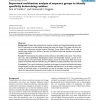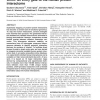51 search results - page 2 / 11 » Identifying Protein Flexibility by NMA |
BMCBI
2007
13 years 5 months ago
2007
Background: Proteins that evolve from a common ancestor can change functionality over time, and it is important to be able identify residues that cause this change. In this paper ...
BMCBI
2008
13 years 5 months ago
2008
Background: The process of horizontal gene transfer (HGT) is believed to be widespread in Bacteria and Archaea, but little comparative data is available addressing its occurrence ...
BMCBI
2007
13 years 5 months ago
2007
Background: Relating features of protein sequences to structural hinges is important for identifying domain boundaries, understanding structure-function relationships, and designi...
NAR
2007
13 years 4 months ago
2007
Systematic mapping of protein–protein interactions has become a central task of functional genomics. To map the human interactome, several strategies have recently been pursued....
IJCBDD
2010
13 years 3 months ago
2010
: The explosion of highthroughput interaction data from proteomics studies gives us the opportunity to integrate Protein-Protein Interactions (PPI) from different type of interacti...



